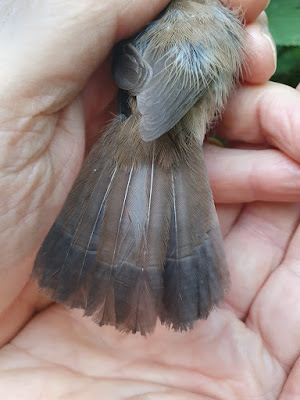It is recognised that all European passerines have 10 primary feathers, which are often numbered for reference, but confusingly this can be done in both directions. Here I am using the system which numbers descendently - meaning the innermost is #1 and the outermost #10.
In some passerine families, such as Alaudidae (larks), Hirundinidae (swallows), Motacillidae (pipits & wagtails), Bombycillidae (waxwings), Fringillidae (finches) and Emberizidae (buntings), the outermost primary (#10) is sometimes very small and difficult to detect (Svensson - Identification Guide to European Passerines).
This is also recognised in Moult and Ageing of European Passerines by Jenni & Winkler: “In some passerine species, the outermost primary is about half as long as the adjacent one (e.g., Wren Troglodytes troglodytes), but in most species P10 is very much reduced. In the Alaudidae, Hirundinidae, Motacillidae, Passcridae, Fringillidae and Emberizidae, P10 is extremely small and difficult to detect under the primary coverts.”
In the guide Moult in Birds by Ginn & Melville, they go one step further and describe the relative length of P10 and give it a description, e.g. for Wren it is P:10 o.r.
This means that Wrens have 10 primary feathers but the Outermost is Reduced (o.r.). But what do these descriptions look like and how do they affect our ability to accurately score moult?
o.r. - outermost reduced
 |
| Wren - P:10 o.r. = outermost reduced |
 |
| Blackcap - P:10 o.r. = outermost reduced |
o.m.r. - outermost much reduced
 |
| Robin - P:10 o.m.r. - outermost much reduced |
v.r. - very reduced
 |
| Dunnock - P9+1 v.r. |
So, for these families, it should be relatively easy to identify P10, or if it is missing, and therefore accurately determine a primary moult score for all 10 primaries.
But what about those families whose outer primary is tiny and difficult to detect?
For these species, Ginn & Melville describe P10 as m. 'minute' or v. 'vestigial'. Like this example for Bullfinch - P:9+1 m.
m. - minute
 |
| Bullfinch - P9+1 m. |
The only passerines with a vestigial outer primary (P:9+1 v.) I can find in Ginn & Melville are Swallow, House Martin, Sand Martin and Bearded Tit.
Vestigial “is most often used in biology to describe something that either didn’t finish developing or has become, through evolution, pretty much useless”.
So, it’s pretty difficult to allocate a moult score to a feather we may not even be able to find.
Fortunately, guidance from the BTO, as found in A Field Reference Guide for Ringing and Nest Recording allows that for passerines with P10 which cannot be accurately scored, X, small outer feather not scored, can be added to the primary moult score, e.g. 555555432X.
However, with some knowledge of the length of the outermost primary and the expected moult sequence of passerines, some judgement should be used here. For example, if P9 is still an old feather then in all probability P10 will also still be an old feather. Likewise, if P9 is a new, fully grown feather, it is highly likely that primary 10 is also a new, or very nearly, fully grown feather. In these instances, the appropriate score can be added.
Mick P











.jpg)




